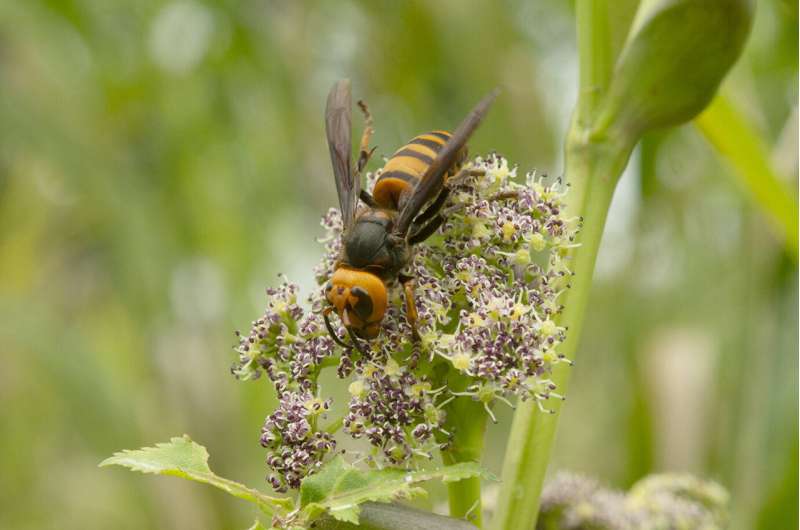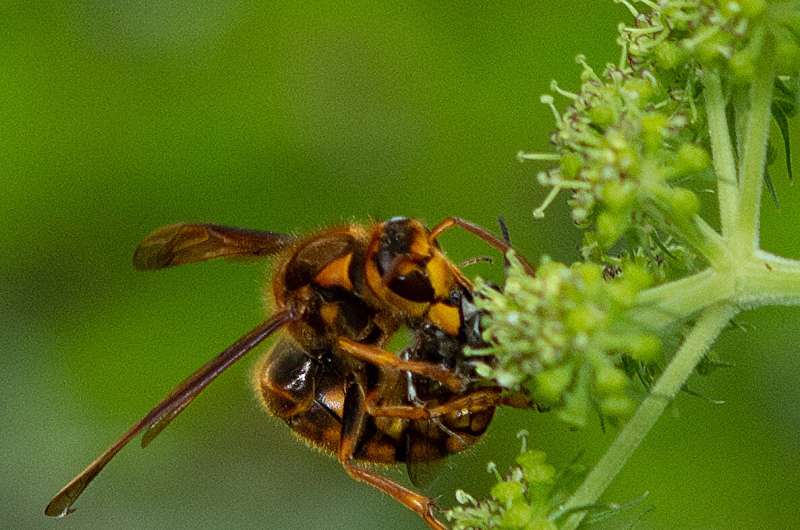This article has been reviewed according to Science X's editorial process and policies. Editors have highlighted the following attributes while ensuring the content's credibility:
fact-checked
peer-reviewed publication
trusted source
proofread
Hornets found to be primary pollinators of two Angelica species

Researcher Ko Mochizuki of the University of Tokyo discovered that two species in the genus Angelica are pollinated primarily by hornets. This overturns the conventional belief that Angelica species are "generalists," meaning that there is not one primary pollinator but a variety of species. As hornets are rarely primary pollinators, the discovery also impacts future ecological research and conservation efforts. The findings were published in the journal Ecology.
White, small, open, secretes nectar and produces pollen: these are the kinds of flowers that many types of insects can reach and are attracted to. Most of the plants in the carrot family, Apiaceae, fit this description perfectly. As such, the species in this family are considered to be generalists. In extreme cases, over 100 different insect species visit their flowers. Not so with Angelica decursiva and Angelica hakonensis, two species in the genus Angelica in the family.
"I observed a fierce visitation by hornets for the first time in 2015 in Nagano Prefecture," Mochizuki recalls, "and then again in 2018 in the Nikko Botanical Garden where they were feeding on the nectar of the inflorescences of A. decursiva and A. hakonensis. Since it was a dogma that species in the family Apiaceae are generalists, this observation motivated me to investigate if the two Angelica species were pollinated predominantly by hornets."
Confirming the hunch was a stepwise process. First, Mochizuki returned to the Nikko Botanical Garden to quantify the numbers and types of "visitors" to the flowers. Then, he captured some visitors to check the amount of pollen stuck to their bodies to verify whether it would be enough for pollination.
Finally, he conducted an experiment in which he covered some flowers with a mesh that blocked the hornets and some flowers with a mesh that blocked all insects, with a third group of flowers remaining uncovered as the control group. All three of these methods showed that hornets were the most numerous species that visited the flowers.
"Nevertheless, excluding hornets resulted in seed production higher than expected. I think excluding the hornets allowed other visitors to gather on the flowers. Especially considering that I had previously observed hornets hunting and killing other insect visitors when they encountered each other on the inflorescence," Mochizuki explains.

Science advances by incremental steps. Discovering that hornets are the primary pollinator of certain species is one such incremental step, but the consequences are wide-ranging.
"Hornets are generally considered pests in their native range and problematic invasive species in some areas such as North America. Nevertheless, this study underscores the importance of hornets as pollinators, opening new avenues for research and conservation," says Mochizuki.
More information: Hunt and pollinate: Hornet pollination of the putative generalist genus Angelica., Ecology (2024). DOI: 10.1002/ecy.4311
Journal information: Ecology
Provided by University of Tokyo

















